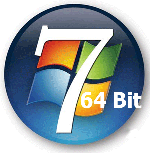64-bit Windows is very simple
 Translation of the post piers7 " 64 Bit Explained " .
Translation of the post piers7 " 64 Bit Explained " .Listen, this truth is nothing complicated.
All programs are in the same place, in% ProgramFiles%, except when you need a 32-bit version, which is in% ProgramFiles (x86)%, except for situations when it comes to a 32-bit machine, in which case they are - still in% ProgramFiles%.
')
All of these libraries, DLL, are still in% SystemRoot% \ System32, they are simply 64-bit now. Well, 32-bit, they are, in% SystemRoot% \ SysWOW64. Do you still follow the explanation? Yes, but 16-bit ones are still stored in% SystemRoot% \ System - it would be strange to move them to another place.
Registry data is in HKLM \ Software, unless you mean data for 32-bit programs, because in this case they are in HKLM \ Software \ Wow6432Node.
In general, the rule is very simple: try to always stick to 64-bit programs, and everything will be in chocolate. Applications without 64-bit versions are in any case not very useful, for example, Office and Visual Studio [1]. Yes, and always install the 32-bit version of Internet Explorer (it is set by default) if you want something from your add-ons to work. The default labels launch 64-bit versions for everything else. Since having two shortcuts to each program is not the best way out, so sometimes (cmd.exe) there is only one (64-bit), and you need to find the second one yourself (all the same, in SysWOW64, of course). And of course, don’t forget 'Set-ExecutionPolicy RemoteSigned' in both 64-bit and 32-bit PowerShell versions.
Next, always install 64-bit driver versions and other garbage, except when it is not (MSDORA, JET), or you need both 32-bit and 64-bit versions (for example, to use MO / SqlCmd from 32 bit process like MSBuild). Just do not do this if the 64-bit installer has already installed the 32-bit version (such as the Sql Native Client).
In general, everything with '32' in the title is intended for 64 bits. All with '64' - for 32 bits. Except, of course,% ProgramW6432%, which is the ProgramFiles directory for 64-bit programs anyway (well, except perhaps on a 32-bit machine). Yes, and the .net framework has not actually moved anywhere, it just has a Framework64 next to it.
Well, that is, I don’t understand why people are so worried about this.
[1] Yes, there is a 64-bit version of Office 2010, but since the installer as a whole does not report it, it does not matter.
Source: https://habr.com/ru/post/102179/
All Articles